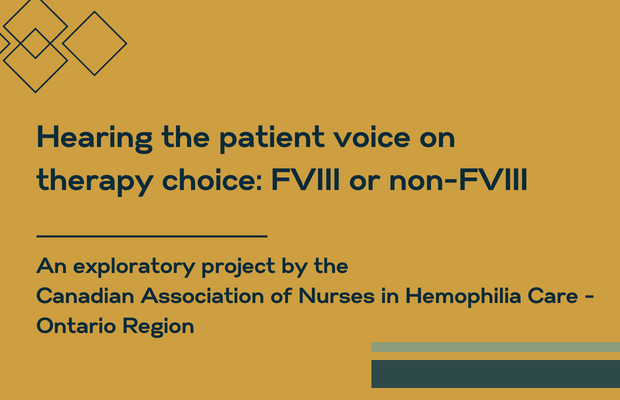Hearing the patient voice on therapy choice: FVIII or non-FVIII

by the Canadian Association of Nurses in Hemophilia Care – Ontario Region* and Sarah Crymble, Ontario Hemophilia Provincial Coordinator
Treatment for patients with hemophilia A (FVIII deficiency) has been consistent since the 1980s with the use of plasma and recombinant clotting factor concentrates. A new non-factor replacement product (emicizumab [Hemlibra]) was introduced in 2019 for patients with hemophilia A and an inhibitor. It was offered in the provinces and territories served by Canadian Blood Services to all patients with severe hemophilia A (less than 1% FVIII) for prophylaxis in October 2021, and in Quebec to all those with clinically severe hemophilia A (including FVIII above 1%) requiring prophylaxis in April 2022. For the first time, patients had a therapy option that allowed a change in administration – subcutaneous rather than intravenous.
The Canadian Association of Nurses in Hemophilia Care – Ontario Region (CANHC-OR) conducted an exploratory project via an online encrypted survey to understand patient perspectives on therapy choice when it comes to FVIII vs non-FVIII therapy. To do this, the survey explored how satisfied patients are with their current FVIII therapy, what attributes they consider when contemplating switching therapies, and information sources utilized when researching the decision to transition to a non-FVIII product.
The exploratory project used a two-phase approach with both pediatric and adult patients. Phase 1 included a 20-minute online encrypted survey for patients in Ontario registered with a bleeding disorder treatment centre (BDTC). Phase 2 included an exploratory telephone interview. Thirty-five (35) patients/caregivers of patients under age 18 participated in Phase 1, and six (6) patients/caregivers of patients under age 18 participated in Phase 2. Of the six randomly selected patients for Phase 2, three (3) were adults and three (3) were caregivers of pediatric patients.
Below are the highlighted themes that were uncovered in the project.
CANHC – OR was interested to understand what attributes were used when considering to switch or not switch to a non-FVIII replacement therapy.
Patients considering switching to a non-FVIII therapy indicated the subcutaneous mode of administration (86%) and less frequent treatments per month (81%) as the main considerations. For those not considering switching to a non-FVIII therapy, 67% of patients indicated they were concerned about not having peaks of FVIII to protect from bleeds when engaging in vigorous recreational activities, 50% indicated they wanted to stay with a company that had a long history in hemophilia therapy. Some noted, “I still need to treat with FVIII if get a bleed” and “It’s still a needle” and “I’m worried I will lose peripheral access as a skill.”
Understanding where participants receive their information about non-FVIII replacement therapy provided insight into what sources of information patients are accessing.
All patients view information from BDTCs, Canadian Hemophilia Society/Hemophilia Ontario (CHS/HO), and published clinical trial data as important/very important sources of information (76%-100%). Seventy-six percent (76%) of caregivers of those under 18 also indicated that information from other patients or caregivers as important/very important. Similar to caregivers, adult patients view information from BDTCs, the CHS and published clinical trial data as important/very important sources of information (81%-94%). Ninety percent (90%) of patients who are considering switching to a non-FVIII therapy received information about new hemophilia therapies from their BDTC, 81% of patients received information about new hemophilia therapies from CHS/HO, and a small portion of adult patients (8% and 15%) access information from published clinical trials data and conferences, respectively, when considering switching to a non-FVIII therapy.
Some patients provided qualitative insight into their thoughts on switching or not switching.
Some adult patients said they felt nervous, scared or uncertain about any switch, stating, “It’s a change,” and “I’m not sure if the new product will be the same.” Yet, “less infusion time to treat,” “mode of treatment,” “having to think/worry less about treatment” and “treating hemophilia will not be a burden” were all positive reasons to switch.
Some caregivers of patients under the age of 18 also felt nervous, anxious, and stressed about transitioning to a new treatment as they were concerned with the “what if’s”, “will it work?,” “how the new product will react,” and “want to see long term data/experience before deciding to switch.” However, less infusions and “Hemlibra would give a sense of normality as if he does not have hemophilia because it is a once weekly treatment” were the noted positive reasons to switch.
In conclusion, many considerations go into a patient/family decision to switch to a new product, including a new non-FVIII therapy. It was shown that while patients/families are generally satisfied with their current therapy, they are contemplating switching to decrease treatments and have the ease of an alternative mode of administration. Also, the history of the company in hemophilia care, peak FVIII levels for vigorous recreational activities, and needing more information still have a place in the overall considerations.
From Canadian Hemophilia Registry data, approximately 875 people with severe hemophilia A are registered with a BDTC, serviced by Canadian Blood Services. As of June 6, 2022, 49% of eligible patients have switched or are scheduled to soon switch to emicizumab.
*CANHC – OR authors: Shamshah Aratia, Vanessa Bourck, Tammy Bourque, Vanessa Bouskill, Kay Decker, Rebecca Goldsmith, Lori Laudenbach, Suzie Ostroski, Elizabeth Paradis, Heather Perkins, Lisa Thibeault, Cindy Wakefield, Grazyna Wozniak and Nicole Zuefle.
This project was supported by an unrestricted educational grant from Takeda.




